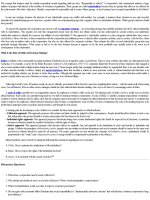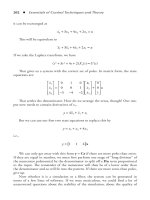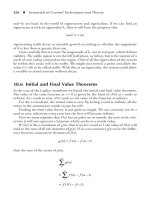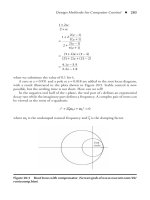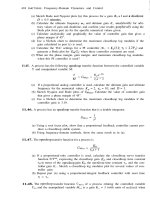ESSENTIALS of Balanced ScorecardMohan phần 8 potx
Bạn đang xem bản rút gọn của tài liệu. Xem và tải ngay bản đầy đủ của tài liệu tại đây (171.17 KB, 27 trang )
165
Treat Balanced Scorecard as a Project
EXHIBIT 9.5
Preliminary Schedule Sample
Target Actual
Task Responsibility Date Date
Kick-off project team.
Rapid prototyping class
Draft project plan.
Complete BSC model:
• Create measures
dictionary.
• Create perspectives
with strategic themes.
• Create linkage to down-
stream measures.
• Create strategy map.
• Develop communication
plan.
Define and generate reports.
Update lifecycle documents.
BSC team review of update
Management review
Incorporate feedback from
management.
Review security design.
Import GL/sales measures
information.
Import manufacturing
measures information.
Manager review
Develop reports
Present results to
management team.
4239_P-09.qxd 3/11/04 9:12 AM Page 165
166
ESSENTIALS of Balanced Scorecard
Define the Level of Involvement for Each Consultant
and Vendor
BSC projects can be complex challenges if the roles of consultants, ven-
dors, and the in-house teams are not defined. Up front, successful pro-
gram leaders identify the required functions for each of the players and
then manage their effectiveness.Exhibit 9.6 illustrates such a mapping for
a project. Once this responsibility chart is drawn, any resource mix-ups
or role misunderstanding will be identified.Also, resource problems will
be brought out in the beginning of the process. Some BSC projects have
lasted so long that the staff on the project leaves or changes. It is very im-
EXHIBIT 9.6
• Business model design
• Selling top management
• Business design
• Commitment gathering
• GL and expense forecasts
• BSC measures and model optimization
• Systems integration
• Custom report creation
• Data warehouse connections
• EIS/OLAP reporting
• Project management
• Goal/model congruence
• Technology project management
• Software installation
• Systems configuration
• BSC model design
• Model implementation
• Model design reviews
Consultant
Program
manager
Project
lead
Applications
services
In-house
BSC modeler
IT engineer
Types of Work in BSC Project
4239_P-09.qxd 3/11/04 9:12 AM Page 166
167
Treat Balanced Scorecard as a Project
portant to know the level of contribution and participation demanded of
each member so that resources can be brought in to fill the need.
Manage Your Dictionary
Many BSC projects end before they begin.These projects tend to man-
age using all the sophisticated technology, strong management support,
and project management but still stumble. The secret ingredient seems
less process-oriented than content-specific. The use of a dictionary is
critical to establishing the language of the project. Exhibit 9.7 illustrates
a sample page in a dictionary for performance measures. Similar dictio-
naries must be created for all other aspects of endeavor so that organiza-
tional memory does not fade. Note that it describes the nature of the
performance measure—that is, leading/lagging, its source, the activity it
supports, its members, its process parents, inputs, the type of its measure,
and possible target measures, among others. Further additions include
when and how to collect its data.
EXHIBIT 9.7
Performance dictionary #:
Strategic theme:
Objective:
Description:
Performance measure type:
Leading/lagging indicator:
Target:
Measure:
Other attributes:
Source data:
Comments:
Period:
Owner:
Linked with and to:
Why is this measure important?
Performance Measures Dictionary
Item Sample
4239_P-09.qxd 3/11/04 9:12 AM Page 167
168
ESSENTIALS of Balanced Scorecard
A performance measures dictionary isolates the more important
contents of the BSC model prior to beginning the project. This may
seem tedious initially as it may seem that the momentum of the project
is compromised when everyone sits in a room defining activities. The
value of this exercise will only show itself later in the project.
Establish a Tools Inventory
Just as a map defines a landscape, a tools schematic topologically identifies
the necessary tools/solutions the project will use. Exhibit 9.8 illustrates
such a topological view of tools. Alternative tools could also assist your
project and safeguard technology crises that may surface. If alternatives
are identified, the project must ensure that data models can be convert-
ed prior to the development start.
EXHIBIT 9.8
Financial
system
performance
data
Data
converter
XML
Staging
PM
data
Sales forecast
Report from
employees
Customer
measures
BSC
application
Import
Conceptual Tools Inventory
4239_P-09.qxd 3/11/04 9:12 AM Page 168
169
Treat Balanced Scorecard as a Project
Summary
Treat a BSC exercise as a project using project management. If an orga-
nization begins a BSC exercise with a one-time-only mentality, the pro-
ject will never take off. In fact, the project team will inherently believe
in relief and will cut corners to ensure success.This will only push off big
decisions and mortgage the future for the present. It might be good to
consider this BSC program as one would view the education and intro-
duction of a new product that has customers to satisfy, engineering to
Regence Group Takes
the Right Perspective
The Regence Group combined five separate businesses under one
umbrella several years ago. Each operation ran under its own man-
agement and board but under the guide of The Regence Group.
The group experienced difficulties in its initial years in aligning
authority, accountability, and roles in executing toward a vision. It
realized a key problem was the lack of a single strategy to guide
the combined enterprise. It undertook a business transformation
process. Balanced Scorecard was a key tool for implementing it.
BSC was the obvious tool to align each organization under a strate-
gic umbrella. The executive team directed a team to research and
understand the value proposition offered by a BSC implementation.
The team researched the issues and proposed their ideas to the
management team, who then instructed the team to go forward.
BSC could have taken on a life of its own then.
Realizing that BSC can function only when a strong strategic direc-
tion has been established, Mark Ganz, CEO of The Regence Group,
instituted a strategic planning process to identify key strategic
thrusts that are now the key feeders into the BSC process.
I
N THE
R
EAL
W
ORLD
4239_P-09.qxd 3/11/04 9:12 AM Page 169
170
ESSENTIALS of Balanced Scorecard
educate and guide, and sales to ensure revenue.This mentality could re-
mind the team that they serve, not institute, change and that they must
constantly sell their ideas and their product.
The best sign of a successful BSC program is when the audience asks
for more and more adjustments.This is not a bad sign because only users
ask for more. The BSC exercise is a project-planning exercise and a
market-introduction exercise rolled into one. Hence, using project
scheduling, deliverable planning, and overall guidelines of project man-
agement, BSC will live.The use of consultants and other outside help
is not all bad, but one must ensure that they are carefully guided and
rewarded.
4239_P-09.qxd 3/11/04 9:12 AM Page 170
Success Factor Five: Use
Technology as an Enabler
171
CHAPTER 10
After reading this chapter, you will be able to
•
Recognize three classes of BSC systems.
•
Understand common subsystems of any BSC system.
•
Decide which software vendor to work with.
A
s discussed earlier, there are three main aspects to any business
transformation:
1. People issues
2. Process issues
3. Technology issues
This chapter deals with the technology issues even though the people and
process issues cannot be separated from this discussion. There are several
overlaps as people implement technology and process enables technology.
Three classes of BSC systems exist:
1. One that is integrated into legacy and accounting systems—called
enterprise performance management (EPM) systems or enterprise
resource planning (ERP) systems
2. One that is best-of-breed analytic application used alongside in-
tegrated enterprise system—called analytic applications or busi-
ness intelligence applications
4239_P-10.qxd 3/11/04 9:11 AM Page 171
3. An in-house designed-and-built system—called internally devel-
oped applications
In all these systems, the following subsystems must exist for the correct
delivery of an effective BSC system (see Exhibit 10.1):
•
Data collection and input subsystem
•
Modeling and analysis subsystem
•
Reporting subsystem
•
Deployment subsystem
•
Predictive and planning subsystem
•
Infrastructure subsystem
172
ESSENTIALS of Balanced Scorecard
EXHIBIT 10.1
Data collection Modeling and analysis Reporting
Deployment
Predictive and planning
Infrastructure
What Makes a BSC Software System?
4239_P-10.qxd 3/11/04 9:11 AM Page 172
Data Collection and Input Subsystem
The importance of data collection is only understood after the first BSC
exercise.At the pilot, the information gathered through interviews, com-
bined with tapping ASCII (text-based) data dumps from heterogeneous
databases, seems trivial. The initial excitement in the organization and
hence, its openness to cooperate, is high. Everyone is willing to spend
time and money on a first try. Everyone is also willing to hardcode the
connections with data and not wonder what to do when the data struc-
tures change. One good side effect to finding out where the performance
measures reside is that more often than not, there is more than one lo-
cation where the same data lives. Consolidating these locations into one
can “save untold dollars spent on entering data in several locations,” as
Subaru-Isuzu Automotive Inc. discovered.
1
When repeated data and structures of the model must be replenished
continuously, the real challenge to the maintainability of the system sur-
faces. Many BSC systems provide data collection tools that provide elec-
tronic data replenishment (EDR) tools, that is, tools designed to assist in
repeated data collection of performance information that is found in
multiple sources including data found in peoples’ heads.
EDR is not focused on collecting data for the first time. Many other
methods and systems allow for this.The biggest challenge in data collec-
tion is in data replenishment, that is, gathering data the second and third
time from the same people. Data can be transaction information but also
information found in peoples’ heads; empirical information is essential to
the process. BSC projects, using technology, can gather information
found on systems, but empirical information must be gathered using
online surveys or with interviews. Exhibit 10.2 illustrates this variety of
information-gathering methods, pushed into a Balanced Scorecard
datawarehouse or a navigations engine.
173
Use Technology as an Enabler
4239_P-10.qxd 3/11/04 9:11 AM Page 173
174
ESSENTIALS
of Balanced Scorecard
EXHIBIT 10.2
Trade-Offs of Each Data Source Gathering
Interfaces Purpose Advantages Disadvantages Comments
ASCII Importing, exporting ASCII Quick access. Simple One time only. It must
data files are input in interface, and defined take all the ASCII data
specified format. among many software like a spoon takes food.
packages.
ODBC Query Standards-based query Very directed and selective Must learn the query
engine can grab informa- connection to data. Very engine language.
tion selectively, like chop- scripted and repeatable.
sticks can pick food items.
Web-Based Empirical knowledge; that Gets to information found Must understand another
Survey is, information not found in peoples’ heads, not feature of the system to
Tools on systems can be systems. Is anonymous, collect information. Sur-
captured. and increases data veys can be intimidating
correctness. Repeatable to noncomputer-literate
and measurable because users and might not get
you can find out how all the salient effects
4239_P-10.qxd 3/11/04 9:11 AM Page 174
175
Use Technology as an Enabler
many really responded derived from eye-to-eye
and urge more response. interviews.
Less time-consuming
than interviews.
Spreadsheet Simple input mechanics. Nonintimidating input and Too simple. Cannot
output. Graphical con- collect vast amount of
nections are known and data because spreadsheet
understood. runs out of steam with
limited storage capabilities.
Data collection is unidimen-
sional unless you spend
time to create multiple
dimensions.
XML-Based eXtensible Markup Becoming a strong stan- Requires technical exper-
Query Language devised to dard in the industry for tise to understand the
Methods create a standard method application developers. language formats. May
for applications to speak Highly efficient way to grab not be applicable for
with each other. data from various data legacy systems.
sources.
4239_P-10.qxd 3/11/04 9:11 AM Page 175
176
ESSENTIALS of Balanced Scorecard
Input and output subsystems take the following forms:
•
ASCII importing and exporting
•
Object data-base connectivity (ODBC) connections with a
query engine (EDR tools)
•
Survey-like Web-based input and output systems (EDR tools)
•
XML
2
(eXtensible Markup Language) data interfaces.
Some installations have several connections to heterogeneous per-
formance data sources. In certain organizations the data are found only
in peoples’ heads. Service companies, for example, tend to have time
information but not to have performance information logged in sys-
tems. Manufacturing companies who have systems tend to have some
manufacturing-related information on-line and might only have them
handled on the shop floor. Data collection can be vast or targeted.All this
depends on the expanse of the BSC model being created. If you have
1,000 objectives and 400 performance measures with 2,000 initiatives, it
will take more time in setting up systems versus populating 10 objectives,
19 performance measures, and so on. In the case of the Canadian De-
partment of Defense, in particular the Army of the Canadian Forces, its
software, Panorama Business Views, a BSC vendor, was set up to cover
the following:
•
4 organizational levels of management
3
•
250 users in 200 locations
•
1,289 measures feeding 35 indicators per scorecard
Exhibit 10.3 shows the various data sources and the tools that can
connect them into the BSC datawarehouse.
4239_P-10.qxd 3/11/04 9:11 AM Page 176
Modeling and Analysis Subsystem
In order for a thorough capture and evaluation of the strategic drivers of
an enterprise, a periodic snapshot of the flow of key strategic objectives
and its associated performance measures is essential and forms the basic
foundation for the development of a BSC model.
As discussed in prior chapters, many organizations are satisfied with
strategy modeling at first but very quickly realize that their model needs
to be extended to measure costs and include revenue, profits, and a host
of other objectives and measures. Some associate the model as a measure-
ment backbone for other initiatives or other measurement subsystems.
177
Use Technology as an Enabler
EXHIBIT 10.3
BSC
data
model
Drilldown
forms
Query
engine
Electronic
surveys
Financial and
operational
systems
Strategy
ASCII
Reports
Performance
measurement
Spreadsheet
connection
Data Sources and Tools
4239_P-10.qxd 3/11/04 9:11 AM Page 177
For example, organizations might relate EVA (economic value added)
4
to
activity-based costing (ABC) or total quality management (TQM) pro-
jects, often wishing to uncover deeper analysis from the scorecard.
Hence, BSC systems can take a deeper role than basic scorecarding
of performance management elements. In a nutshell, the modeling and
analysis subsystem can create several views of the objectives, initiatives,
measures, targets, and metrics data:
•
The classic BSC framework with its performance
measurements
•
The process views showing the relationship of activities to each
other and their parents—namely, tasks and processes
•
The multidimensional views such as profitability by channel or
by product or many more—a “slice and dice” model often
called OLAP and popularized by companies like Cognos Corp.
•
The scorecard view that uses this base to reflect performance
metrics held by the organization
Reporting and Deployment Subsystems
BSC teams gain an enormous understanding of their own company
from the inside out and begin to ask the questions that place them on the
road to improvement. BSC helps frame the corporate strategy.
Key to this learning is the “Report-out” meeting held to impress the
management of findings.All multifunction project teams conclude their
work with presentations.These presentations report on the model’s out-
put and response to queries about the work performed.These meetings
seem always to come too early. Many a sleepless night is spent to win in
these presentations, and the emotions of all concerned are high.
Reporting subsystems are critical at this moment. They produce
two-dimensional reports with graphs that bring the entire data gather-
ing, modeling, and analysis exercise into perspective.
178
ESSENTIALS of Balanced Scorecard
4239_P-10.qxd 3/11/04 9:11 AM Page 178
Today there are two ways to report on the project data:
1. Built-in reports from the software. Custom reports designed specific
to the special organization expectation. Some custom report writ-
ers also have a built-in query engine that grabs information just as
a data collection engine does.These engines allow for custom re-
ports to be built through the design of reports with links to data
elements within the BSC model.Then, anytime you want a report
to update you on the status of the information, just run the en-
gine. Furthermore, enhancement to this approach touches the
fields of data mining—often called report mining. Here, scripts can
be set up to awaken the query engine, interrogate the models, and
invoke the reporting subsystem when certain data triggers
occur—that is, if a measure exceeds $5 million for product X.
Exhibit 10.4 illustrates such a configuration for report mining.
179
Use Technology as an Enabler
EXHIBIT 10.4
BSC
model
Query
engine
Reports
triggered
Automation
engine
Engine is ready to invoke
the query engine, which tests high-
and low-water marks and other
changes in model.
Query engine will extract
or input data to and from
model to generate report.
It can also test values
and thresholds.
Report Mining
4239_P-10.qxd 3/11/04 9:11 AM Page 179
2. Custom-built, computer-derived files that permit personal, multidimen-
sional computer investigation by management. Each file uses data nav-
igation software to drill down and analyze the data.These tools are
also called executive information systems (EIS) or business intel-
ligence (BI). Being a refreshing adjunct to flat reporting, these
tools permit the user to interrogate the data and navigate through
a succession of graphs, drilling down to uncover the true causes or
other dimensions in their model. See Exhibit 10.5.
Predictive and Planning Subsystems
C. J. McNair, professor of management accounting at Babson College,
states,“Knowing the score isn’t the goal—changing it is.”
5
In the end, it’s
not the information on your desktop that is key; it’s the accuracy, time-
liness, and the applicability of the decisions you make from it.With BSC,
managers no longer deal with the present using data from the past.
Inherently, they all want to predict the future.Thus far, the tools available
to them have been limited and not everyone has the time, the training,
or the energy to develop elaborate models of reality.
180
ESSENTIALS of Balanced Scorecard
EXHIBIT 10.5
General ledger
Operational data
Empirical data
Multidimensional
BSC Data Model
EDR Data Sources
4239_P-10.qxd 3/11/04 9:11 AM Page 180
However, the BSC framework provides some strong insight to per-
form predictions and planning. BSC, being an umbrella to the overall
performance framework of an organization, can frame the performance
data and consolidate information from many other analytic application
data repositories, such as the following:
•
Activity-based budgeting
•
Cost management systems
•
Sales reporting systems
•
Manufacturing process management systems
•
Claims management systems
•
Target costing
•
Process measurement and tracking—time-based simulations
•
Capacity planning
•
Yield analysis and predictions
•
What-if analysis
All of these opportunities for further analysis can be reflected from
any BSC system under the predictive subsystem.
Infrastructure Subsystem
In more advanced BSC systems, infrastructure holds disparate tools in
place and permits the user(s) to manage the information flow through
them. Infrastructure controls the licenses in the toolset and restricts ac-
cess at various levels of the software. Some packages are stand-alone PC-
tools; others are LAN or enterprise-based (local area network) network
accessible frameworks that hold and monitor access to tools.
Issues of security, licensing, and network capabilities are key concerns
to most corporate system administrators and IT professionals. No two
BSC systems are built alike with the same administrative paradigm in
mind. They must always be built on general-purpose computing envi-
ronments, and your IT-professional can assist you in that diagnosis.
181
Use Technology as an Enabler
4239_P-10.qxd 3/11/04 9:11 AM Page 181
One way to get a start on this is to ask the following questions:
•
How do I plan on using this information system, that is, from
my computer or on a network?
•
How many people must have access to the system, and at
which phases of the project?
•
What are the key tools I will need to get the job done?
•
Who will maintain and help me fix problems within my
company?
•
Do I need this tool to be a client-server? LAN-based network?
Or stand-alone?
Virtual Nature of Subsystems
These subsystems can exist on multiple systems with heterogeneous base
architectures and databases. For example, the organization may have an
EPM that handles BSC, product-costing, and operational reporting,
while certain elements of ABC modeling and profitability modeling are
handled by an off-line, connected PC-based system. Technology and
methodology have advanced to a level where the physical location of an
application is secondary to the functionality of the application environ-
ment. Hence, the location of applications can be less important to the
work. New architectures are evolving to support the key managerial
processes like BSC and are becoming less of the main challenge.
Deciding Which Software Vendor to Work With
Every datasheet tells the same story but is equally exaggerated. Ever visit
a tradeshow? After a short while on the tradeshow floor, all the products
and all the sales people look like they work for the same organization,
don’t they? They seem to say all the same phrases and deny all the same
accusations. Everyone seems to be the “market leader,”“dominant,”“high
performance,” and “undisputed choice.”
182
ESSENTIALS of Balanced Scorecard
4239_P-10.qxd 3/11/04 9:11 AM Page 182
The key questions still remain in the exercise of making the purchase
decision:
•
How does an organization truly differentiate one from another?
•
How does an organization purchase one package and vendor
and adjust as the needs of the organization change?
•
What do I do if my consultant recommends a vendor against
my own instincts?
Rules of Engagement in Understanding a Vendor
Clearly, no two software vendors have the same personality.They are dif-
ferent from the way they build software to the way they market them.
There are nine rules of engagement that can assist in comparing and un-
derstanding vendors in the analytic BSC environment. The following
nine rules of engagement serves to assist in evaluating a BSC software
provider:
1. Understand organizational needs.
2. Make a rational decision using a process with checklists and
reviews.
3. Evaluate more than software.
4. Don’t use the vendors to learn BSC exclusively.
5. Visit your vendors and tour.
6. Don’t get caught in trends.
7. Always keep in touch with the market.
8. The nature of the dance is the nature of the relationship.Watch
and measure all aspects of the relationship with the vendor.
9. Control the demonstration.
183
Use Technology as an Enabler
4239_P-10.qxd 3/11/04 9:11 AM Page 183
Understand Organizational Needs
If you don’t know beauty, then everyone looks beautiful. Understanding
your needs and also your ability to absorb your needs are the keys to any
process of evaluating and working with others. Many BSC projects start
on the wrong foot—lack of planning around the demands of the orga-
nization.There are several questions to ponder:
•
Does the organizational team agree that the tools to be pur-
chased cannot substitute the process and people issues to be
tackled?
•
What portion of data gathering does the team believe is manu-
al or computer controlled?
•
What can the team and organization absorb in terms of sophis-
ticated software modules?
•
Is the organization technology-averse and demanding of
technology?
•
What kind of User interface works for the extended
organization?
•
What data management requirements are anticipated and can
the internal IT groups support the system?
Make a Rational Decision Using a Process with
Checklists and Reviews
The team evaluating these vendors must understand the priorities of
these needs and the appropriate trade-off your management team and
you are willing to discuss. Even though compromise is the essence of the
evaluation process, a haphazard, gut-feel approach will give room for er-
rors in judgment.Without a practical process to guide your evaluation,
emotion, bureaucracy, politics, and irrational conjecture will flood your
decision-making system.The following suggestions are for selecting the
vendor:
184
ESSENTIALS of Balanced Scorecard
4239_P-10.qxd 3/11/04 9:11 AM Page 184
•
Select a team to perform the selection.
•
Establish agreed-upon timelines for the requirements develop-
ment, the request for proposal formats, meeting times, decision
processes, and the vendors that are on the list.
•
Determine key criteria needed to select the candidate vendors.
Evaluate More Than Software
There are few barriers to entry in software.All it takes is an office, soft-
ware engineers, and a phone to bring a software company to life. Great
software companies are more than this. They are systems built to carry
you through the hard times and to support you through your growing
needs for results. In your evaluation, consider that you are not evaluating
a product or a service but a new alliance with a company that has pro-
posed to serve you. Software is changing all the time, and as you assess
the use of any software package, you should assess the relationship you
will be having with the respective organization. Recognizing that soft-
ware is only the device part of the product, other components are
brought together to make the product whole:
•
The service component
•
The support infrastructure
•
The company itself, the relationship your company can count
on
•
The financial infrastructure backing the company, and so on
Don’t Use the Vendors to Learn BSC Exclusively
In many demo situations, clients ask basic questions about BSC and how
it can be applied. Software vendors will always educate you about the in-
dustry and the market, but for one reason—you buy their solution. It is
important that the purchasing organization rely on more than vendor
knowledge to accelerate the project.
185
Use Technology as an Enabler
4239_P-10.qxd 3/11/04 9:11 AM Page 185
Most software vendors are trained to educate you on the subject, but
to also set the barriers in features and benefits against their competitors.
The under-educated client could be led astray following a vendor’s
agenda.
In these demo circumstances, you must ensure that your team is well
versed with the requirements and with the expectations of a meeting.
Software vendors are useful learning resources, but they should not be
the sole source of your education.Your organization should develop a
model for educating itself prior to the demo.
Visit Your Vendors and Tour
Software and systems vendors who are proud of their growth and want
to take advantage of their reputation will share everything about them-
selves.They tend to invite you to visit their offices and tour their facili-
ties. Many BSC software vendors are smaller and tend to work out of
smaller offices. Others are really sales offices with research and develop-
ment overseas. It is important to meet the customer support profession-
als who will help your when the going gets tough. Furthermore, you
must understand their quality-assurance procedures, if any. This could
save you from disaster.
Before you go on the trip, make sure to do the following:
•
Set the agenda and meet senior management.
•
Present your strategy to them and make them accountable to
your needs.
•
Observation skills must be used during a tour, for example,
observe their sales organization and see if they are busy.
•
Talk to the engineers and ask them BSC questions.
•
Find out how many are working on your product purchase.
•
Visit the office of your sales representative and see what the
rep’s environment is in the hierarchy of sales.
186
ESSENTIALS of Balanced Scorecard
4239_P-10.qxd 3/11/04 9:11 AM Page 186
All in all, the best way to pick a vendor is to visit one.Then move
from vendor-client relationships to a partnership.
Don’t Get Caught in Trends
Many BSC projects are change-management projects.Visionaries lead
these projects, and they are filled with the endorphins of possibilities.
This is a needed characteristic for dramatic change. However, the very
characteristics that change agents possess can be the source of their
downfall if not held in check.
In the early phases of a project, the appetites of organizations are
large and their digestive systems seem to have the unlimited capacity for
technology adoption.
Trends in new advances can only accentuate our addictions for tech-
nology.These are valuable technologies of the future but note that one
cannot build tomorrow on tomorrow’s technology. One can only build
tomorrow on today’s technology. Hence, test the ability of the vendor to
be honest and direct about what has been tested and works versus what
is being tried on your organization.
Always Keep in Touch with the Market
Loyalty is a virtue. In BSC projects, the risk of implementation is inher-
ently high and sometimes loyalty to one vendor can be a mistake.
Generally, almost 50 percent of technology implementations fail to meet
expectations. One way to prevent any setbacks in the technology ele-
ments of the project is to hedge your bets by creating alternatives to your
technical implementation. Portability of your modeling environment re-
quires that you examine more than one vendor and keep them close at
hand in case trouble brews.
Keeping multiple seconds and one loyal partner is difficult, especially
since you have trained all your people on a certain technology.The one
187
Use Technology as an Enabler
4239_P-10.qxd 3/11/04 9:11 AM Page 187
great advantage is the standards that have been built around BSC, and this
will assist in portability and redundancy.
The Nature of the Dance Is the Nature of the
Relationship: Watch All Aspects of the Relationship
The customer-vendor courtship is much like a marriage courtship.
Obviously, the first date is a wonderful experience for many, but can it
188
ESSENTIALS of Balanced Scorecard
Remember the Ten Questions
The following ten questions will help profile a BSC vendor.
᭹
1
Is the BSC vendor more than a one-product company or a
one-product group with no diversity in its BSC offering?
᭹
2
Is the BSC vendor a software company or a consulting firm in
disguise?
᭹
3
How large is the vendor’s installed base in BSC?
᭹
4
Does the vendor support the BSC products with training and
technical services?
᭹
5
Does the vendor have support of an active, international user
group? Does the vendor have regional BSC user group meetings?
᭹
6
Does the BSC product adhere to industry standards?
᭹
7
Does the BSC product support an open standards-based
interface?
᭹
8
Does the BSC product have a technical and feature migration
path?
᭹
9
Does the BSC product support an interface to other productiv-
ity tools like process modeling, activity-based costing?
᭹
10
Does the BSC vendor support an integrated BSC environment?
T
IPS
& T
ECHNIQUES
4239_P-10.qxd 3/11/04 9:11 AM Page 188
last? Through this courtship, you will come to understand the style of
your prospective partner and how they view a partnership.
Some vendors like selling futures, while others only sell the present and
never talk about the future. Others are hungry enough to work with you
regularly while others will disappear when the purchase order is cut. Some
keep commitments while others promise but deliver late. Do you want
someone who accepts your idiosyncrasies or one who challenges them?
Throughout the process of meeting, understanding, and purchasing
software for BSC, your organization must assess the value and the future
of the partnership.As we all know, partnerships are always deemed to be
strategic even when they are merely tactical and short-term. So, the se-
lection of a vendor for software must be categorized as one or the other
and treated that way.
Control the Demonstration
Many demos are considered the ultimate decision point. Realistically,
they are like beauty contests when they should be like fitness tests.They
are staged events that make or break a sales opportunity.This emphasis
may be due to the “seeing is believing” mentality in the buying process.
Yet, what you see might not be what you get. Often, the software
providers control demos.They follow tight and fail-safe scripted demos
that highlight the power of their solution and loosen your mental grip
on their competitors.
So, the ultimate lesson to learn is not to let this happen but to con-
trol the sources of information used in a demo; control the issues dis-
cussed; control the decisions to be made; and control the attendees’
expectations.
If you tend to a free-form engagement of ideas and expectations, you
will get exactly that—just ideas. The following checklist hints at orga-
nizing the meeting based on requirements and expectations:
189
Use Technology as an Enabler
4239_P-10.qxd 3/11/04 9:11 AM Page 189
